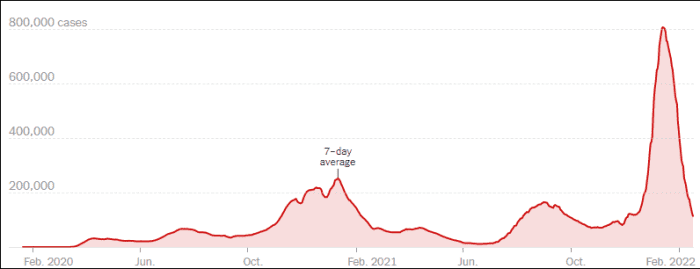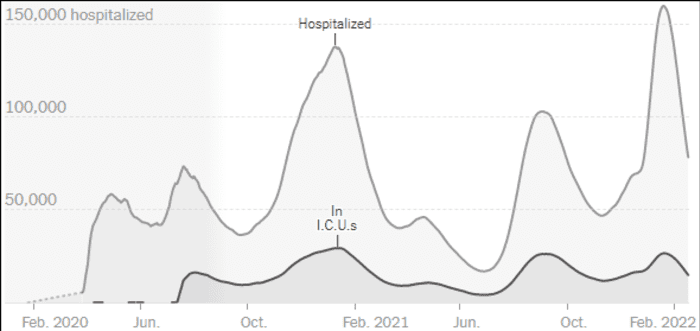This post was originally published on this site
With new daily cases of COVID-19 falling to levels seen before the omicron variant became dominant, even as daily deaths remain stubbornly high, the narrative has swung to how states are preparing for a post-pandemic world.
White House officials and Centers for Disease Control and Prevention head Dr. Rochelle Walensky have said they are preparing for a future in which COVID-19 is no longer a crisis. And California announced a new plan Thursday, making it the first state to shift to an “endemic” approach to COVID from one dealing with a pandemic, that emphasizes prevention and reaction to outbreaks rather than mandated masking and business shutdowns.
And Hawaii is now the only state that hasn’t announced a date in which it will lift its indoor mask mandate, after Washington and New Mexico did so on Thursday, as USA Today reported.
The seven-day average for new COVID-19 cases fell 113,964 on Thursday, down 68% from two weeks ago, according to a New York Times Tracker. That’s the lowest daily average since Dec. 5, and is just 14.1% of Jan. 14 peak of 806,795.

The New York Times
For a comprehensive daily rundown: Follow MarketWatch’s daily Coronavirus Update column.
Cases are falling in all 50 U.S. states, with Nebraska seeing the biggest two-week decline of 82%, followed by Washington and Indiana with 80% declines. The smallest decline is Maine at 4%, followed by Idaho at 27%.
The daily average for COVID-related hospitalizations was 78,213 on Thursday, down 40% from two weeks ago, but still at the highest level seen since just after Christmas.
On a bright note, the daily average for COVID patients in intensive care units (I.C.U.s) fell to 14,824, the fewest since Dec. 6.

The New York Times
The bad news is that while the daily average for deaths continues to slip to 2,306, that was down just 13% from two weeks ago, and was still well above the Sept. 22 peak of 2,109.
The states with the highest average for daily deaths per 100,000 people are Tennessee at 1.5, West Virginia at 1.43 and Arkansas at 1.41, the NYT data show. Coincidentally, the percentage of people fully vaccinated in those states are all below 60%, while the percent of the total U.S. that is fully vaccinated is 64.6%, according to Centers for Disease Control and Prevention data.
In the U.S., 192.96 million, or 74.7% of the adult population are fully vaccinated. Of those at least five years old and up to 17, only roughly 40% are fully vaccinated, according to a MarketWatch analysis of CDC data.
More numbers and news
- An update on a New York Times study showing how the pandemic and vaccinations have been politicized showed that the gap between the number of Republican deaths per capita, and specifically in Trump-supporting counties, and Democrat deaths per capita is still growing, albeit at a slower pace. The following is a chart of the “red COVID” phenomenon:

The New York Times
- The Wall Street Journal reported Friday that the number non-COVID-19 patients in hospitals, that caught COVID-19 while in the hospital, reached a record of about 4,700 during the omicron-variant wave in January. That’s more than four times the peak of around 1,100 patients that acquired infections during the delta-variant wave, and more than double the 2,050 during the height of the first winter surge.
- While cases in the U.S. are falling, South Korea just reported a jump to 109,831 new cases on Friday, the first time daily reported cases topped the 100,000 mark, as the Guardian reported. Daily cases in the country have now more than doubled in just over a week, as they topped 50,000 for the first time on Feb. 10.
- Hong Kong is also facing a its most severe surge in COVID cases. Given the city’s zero-tolerance policy, any person infected with COVID-19 must be admitted to a hospital or an isolation facility. But with hospitals in the city reaching 90% capacity, as the Associated Press reported, those with mild symptoms are now allowed to leave hospitals and isolation facilities after seven days if they test negative.
- The global tally for the coronavirus-borne illness rose to 420.55 million as of Friday, while the death toll grew to 5,866,561 million, according to data aggregated by Johns Hopkins University. The U.S. leads the world with 78.28 million cases and 931,939 deaths.



